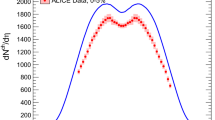Abstract.
The Binary Cascade introduces a novel approach towards intra-nuclear cascade calculations. Like many QMD codes, it uses a detailed 3-dimensional model of the nucleus, and is based exclusively on binary scattering between reaction participants and nucleons within this nuclear model. Like a classical cascade, it uses optical potentials to describe the time evolution of particles passing through the nuclear medium. In the present paper we introduce the model, and investigate its predictive power for hadron spectra in nucleon nuclear reactions final states.
Similar content being viewed by others
References
S.G. Mashnik, A.J. Sierk, J. Nucl. Sci. Tech. S2, 720 (2002); T.A. Gabriel, ORNL/TM-9727, Proceedings of LEP Experimenters’ Workshop on Shower Simulation, Geneva, Switzerland, January 29-31, 1985; J. Cugnon, C. Volant, S. Vuillier, Nucl. Phys. A 620, 475 (1997); Y. Nara, N. Otuka, A. Ohnishi, K. Niita, S. Chiba, Phys. Rev. C 61, 024901 (2000); G. Peter, D. Behrens, C.C. Noack, Phys. Rev. C 49, 3253 (1994); Hai-Qiao Wang, Xu Cai, Yong Liu, High Energy Phys. Nucl. Phys. 16, 101 (1992); A.S. Ilinov, A.B. Botvina, E.S. Golubeva, I.A. Pshenichnov, Sov. J. Nucl. Phys. 55, 734 (1992); A.V. Dementev, N.M. Sobolevsky, Nucl. Tracks Radiat. Meas. 30, 553 (1999); A. Fasso et al. , SLAC-REPRINT-1997-090 prepared for the 3rd Workshop on Simulating Accelerator Radiation Environments (SARE3), Tsukuba, Japan, 7-9 May 1997; D.V. Gorbatkov, V.P. Kryuchkov, Nucl. Instrum. Meth. A 374, 95 (1996); J.F. Briesmeister, LA-7396-M, Rev. 2 and citations therein.
M. Bleicher et al. , J. Phys. G 25, 1859 (1999); H. Sorge, Phys. Rev. C 52, 3291 (1995); K. Niita et al. , Phys. Rev. C 52, 2620 (1995); C. Hartnack, PhD Thesis, University of Frankfurt (1993); GSI Report 93-05; Jörg Aichelin, Phys. Rep. 202, 233 (1991).
J.P. Wellisch, Comput. Phys. Commun. 140, 65 (2001).
GEANT4 Collaboration (S. Agostinelli et al. ), Nucl. Instrum. Meth. A 506, 250 (2003).
Particle Data Group Collaboration (K. Hagiwara et al. ), Phys. Rev. D 66, 1 (2002).
CERN High Energy Analysis Group records, preprint denominations CERN-HERA-YY. For example, E. Bracci, C. Burichetti, J.P. Droulez, E. Flaminio, C. Preti, Compilation of Differential Cross-Sections. Pi Induced Reactions.
V. Lara, J.P. Wellisch, published in Annecy 2000, Proceedings of the IX International Conference on Calorimetry in High Energy Physics, Annecy, France, 9-14 October, 2000, Frascati Phys. Ser., Vol. XXI (2001) p. 449.
M.E. Grypeos, G.A. Lalazissis, S.E. Massen, C.P. Panos, J. Phys. G 17, 1093 (1991).
L.R.B. Elton, Nuclear Sizes (Oxford University Press, Oxford, 1961).
A. DeShalit, H. Feshbach, Theoretical Nuclear Physics, Vol. 1: Nuclear Structure (Wyley, 1974).
K. Stricker, H. McManus, J.A. Carr, Nuclear scattering of low energy pions, Phys. Rev. C 19, 929 (1979).
M. Bleicher et al. , J. Phys. G 25, 1859 (1999).
R.A. Arndt, I.I. Strakovsky, R.L. Workman, Int. J. Mod. Phys. A 18, 449 (2003).
G.F. Bertsch, S. Das Gupta, Phys. Rep. 160, 189 (1988); W. Cassing, U. Mosel, Prog. Part. Nucl. Phys. 25, 235 (1990); T. Maruyama, W. Cassing, U. Mosel, S. Teis, Prog. Theor. Phys. Suppl. 120, 283 (1995).
M.M. Meier et al. , Differential neutron production cross sections for 256-MeV protons, Nucl. Sci. Eng. 110, 289 (1992).
J. Cugnon, C. Volant, S. Vuillier, Nucl. Phys. A 620, 475 (1997).
M.M. Meier et al. , Differential neutron production cross sections and neutron yields from stopping-length targets for 113-MeV protons, Nucl. Sci. Eng. 102, 310 (1989).
W.B. Amian et al. , Differential neutron production cross sections for 597-MeV protons, Nucl. Sci. Eng. 115, 1 (1993).
W.B. Amian et al. , Differential neutron production cross sections for 800-MeV protons, Nucl. Sci. Eng. 112, 78 (1992).
V. Ivanchenko et al. , The GEANT4 hadronic verification suite for the cascade energy region. Talk given at the Conference for Computing in High-Energy and Nuclear Physics (CHEP03), La Jolla, CA, USA, 24-28 March 2003. e-Print Archive: physics/0306016.
EXFOR database. http://www.nea.fr/html/dbdata/x4/ welcome.html
J.F. Crawford et al. , Measurement of cross sections and asymmetry parameters for the production of charged pions from various nuclei by 585-MeV protons, Phys. Rev. C 22, 1184 (1980).
Author information
Authors and Affiliations
Corresponding author
Additional information
Communicated by A. Molinari
Received: 19 December 2003, Revised: 5 March 2004, Published online: 7 September 2004
PACS:
21.60.Ka Nuclear structure: Monte Carlo models - 24.10.Lx Nuclear reactions: general: Monte Carlo simulations (including hadron and parton cascades and string breaking models)
Rights and permissions
About this article
Cite this article
Folger, G., Ivanchenko, V.N. & Wellisch, J.P. The Binary Cascade. Eur. Phys. J. A 21, 407–417 (2004). https://doi.org/10.1140/epja/i2003-10219-7
Issue Date:
DOI: https://doi.org/10.1140/epja/i2003-10219-7




